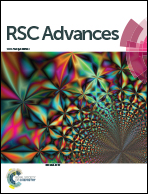Flower-like Bi2S3/Bi2MoO6 heterojunction superstructures with enhanced visible-light-driven photocatalytic activity
Abstract
A prerequisite for the development of photocatalytic technology is to obtain efficient visible-light-driven photocatalysts. Herein, we have reported a flower-like Bi2S3/Bi2MoO6 heterojunction as a novel and efficient visible-light-driven photocatalyst. The Bi2S3/Bi2MoO6 heterojunction has been prepared by a solvothermal method. It consists of flower-like superstructures with diameters ranging from 1 to 3 μm, which are built from Bi2MoO6 nanosheets with a thickness of about 15 nm decorated with Bi2S3 nanoparticles with diameters of ∼3.5 nm. Furthermore, the photocatalytic activity of the Bi2S3/Bi2MoO6 heterojunction has been evaluated through the degradation of rhodamine B (RhB) dye and colorless parachlorophenol (4-CP) under visible-light irradiation (λ > 400 nm). The results demonstrate that the Bi2S3/Bi2MoO6 heterojunction exhibits higher photocatalytic activity in degrading RhB and 4-CP than single Bi2S3 or Bi2MoO6. More importantly, the photocatalytic activity of the Bi2S3/Bi2MoO6 heterojunction is superior to the sum of the activities of two individual photocatalysts (Bi2MoO6 and Bi2S3). The recycling experiment confirms that the Bi2S3/Bi2MoO6 heterojunction is essentially stable during the photocatalytic process. Therefore, the Bi2S3/Bi2MoO6 heterojunction can be used as an efficient and stable visible-light-driven photocatalyst for the purification of the environment.


 Please wait while we load your content...
Please wait while we load your content...